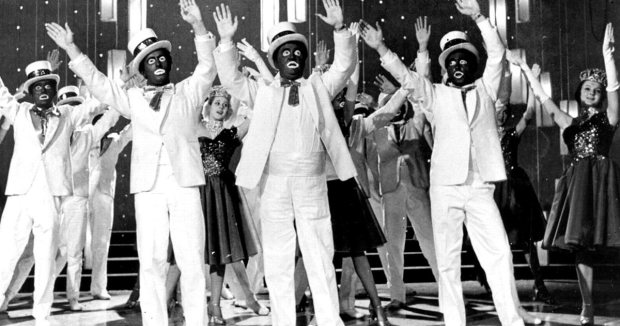Concerning Black Theater Matters (Part II)
Stewart F. Lane’s ”Black Broadway” mirrors both past headliners and today’s headlines.
This is part II of Michael Feingold's latest "Thinking About Theater" column. Click here to read part I.

(© Metropolitan Opera Archives)
If the inhibiting conventions against which African-Americans struggled in the theater, by far the most hated — and till midcentury the most widespread — was blackface. Coming into widespread use with the earliest minstrel shows in the 1830s, it flowed through vaudeville, musical theater, "legit" plays, and film, persisting here until the mid-1950s and even longer in Britain, where The Black & White Minstrel Show was seen weekly on the BBC till 1978.
Blacks and whites both wore blackface during its hegemony in vaudeville, though the former frequently derided and resented it. A recently rediscovered silent film with an all-black cast shows its star, the immortal Bert Williams, wearing his characteristic stage blackface makeup, presumably as a sort of trademark; the others all wear their own faces.
As this suggests, blackface's simple stereotyping concealed a complex mechanism. For Williams, in that film's context, it was equivalent to the elaborate stylized makeup that, in Kabuki or Beijing Opera, indicates the presence of a star. In other situations, it was a formal mask beneath which otherwise impermissible messages, social or psychological, could be smuggled onto the stage. Eddie Cantor once, in a Ziegfeld Follies sketch, played Williams' son, with both men in blackface. In the 1930 film version of Cantor's 1928 Broadway hit, Whoopee (one of the few film productions with which Ziegfeld himself was actively involved), you can see Cantor, disguised in blackface as a "singing cook," compelled by a bigoted sheriff to prove his bona fides by singing and dancing at gunpoint. The notion is rather lost sight of as the number goes on — the sheriff, like everyone else in the scene, is enjoying himself so much he forgets to keep the gun pointed — but the fact remains that someone involved thought the image both germane and viable for a frivolous musical entertainment that featured a white star capering in blackface.

For much of the 20th century, interracial romance was, as theatrical subject matter, a danger-fraught minefield. A handsome photograph in Black Broadway shows Paul Robeson and the white actress Mary Blair (then married to critic Edmund Wilson) standing stiffly in the wedding scene of Eugene O'Neill's All God's Chillun Got Wings. Advance reports of its subject matter had prompted death threats from the KKK, and on its opening night, the NYPD ringed the Greenwich Village Theatre with cops, convinced that the largely white audience would erupt in riot at the moment when Robeson's hand was kissed by Blair.
No such rioting occurred, but the experience stood as prelude to decades of similar onslaughts of death threats and hate mail whenever the subject was broached onstage. The racist anger continued through Deep Are the Roots (1945, its tense mood captured in another of Black Broadway's memorable photos) and racially aware musicals like Beggar's Holiday (1946), Kwamina (1961), and Golden Boy (1964). Since the civil rights era, the audience vociferations and walkouts prompted by biracial touching or kissing have vanished. New York theatergoers see no problem with this changed world. The disheartening part, today, is the extent to which we see, outside our cozy theatrical purview, the still unended floodtides of racist hostility in social media, in thinly veiled political expressions, in bigoted legislative maneuverings, and in the horrific realities of gun violence. The theater can mark stages of visible progress; it cannot serve as a cure-all.
The persistence of racism, and especially its disturbing resurgence in our time as a ploy of right-wing extremism, gives us all reasons to be jumpy. We walk on eggs, striving not to offend anyone, as we look for the cosmetic changes that we can call "diversity." But diversity on the surface is of limited use when injustice suffuses the system. Because I rarely see new movies, I'm in no position to comment on the recent debate about how diverse the Oscar nominations should be. But a column by my friend Michael Phillips, the Chicago Tribune's admired film critic, put it this way: "It's not a matter of implementing some kind of unofficial quota. It's a matter of recognizing what's there, in front of the Academy's face. It's talent going unrecognized."
The old habits of racism die hard. That's why knowing history is a necessity, if we want to move on. As with the Oscars, I don't want to comment on the recent controversy over the off-Broadway production of Mother Courage and Her Children at Classic Stage Company, from the title role of which Tonya Pinkins withdrew, during previews, after what seems to have been a prolonged conflict over interpretation with CSC's artistic director, Brian Kulick. Such conflicts happen often, at varying degrees of amicability, but they don't often involve, as this one did, both racial issues and a high degree of visibility.

I don't claim to know who's in the right. After reading Pinkins' and Kulick's public statements, I believe there was something to be said on both sides, and I fervently wish the discussion had happened before rehearsals began. In the event, Kecia Lewis, replacing Pinkins at the very last moment, invested the role with ferocious authority, passion, and cunning, even while struggling for lines. And some of her colleagues, especially Kevin Mambo and Michael Potts, as the Cook and the Chaplain respectively, tapped into a genuine Brechtian vein. Albeit stumblingly, the work's sense came through.
Yet the question remained: Why was it necessary to move Mother Courage from northern Europe to the Congo, from the Thirty Years' War to today? Would Pinkins or Lewis be so unimaginable, bullying her kids and hauling her cart through Sweden and Poland? The transposed setting brings me uncomfortable recollections of Carmen Jones, and I can see where a strong-minded actress might find matters to dispute within it. When Mattiwilda Dobbs sang Gilda at the Met in 1956, nobody thought she was out of place in Renaissance Mantua. At the same time, I support a director's right to set a familiar play where he feels it will resonate most strongly for his audience; today's Met Gildas, whatever their ethnicity, no longer sing in Verdi's Mantua but in Michael Mayer's Las Vegas.
What's most important, I think — the good that came out of the CSC dispute and will come out of the Oscar controversy — is the awareness that other people are people, that when we speak of "everybody," we can't reflexively omit large groups of somebodies from our consideration. (Or as Pinkins perceptively put it in the CSC discussion, "Black Perspectives Matter.") People who have historically gotten the short end of the generalization do not relish being generalized about. To celebrate their individual achievements, or their history, means celebrating the share they have in the nation's whole life. For all Americans to realize that would be the ultimate recognition.
Michael Feingold has twice won the George Jean Nathan Award for Dramatic Criticism, most recently in 2015 for his "Thinking About Theater" columns on TheaterMania, and has twice been a finalist for the Pulitzer Prize in Criticism. He serves as chairman of the Obie Awards and has also worked as a playwright, translator, and dramaturg.









